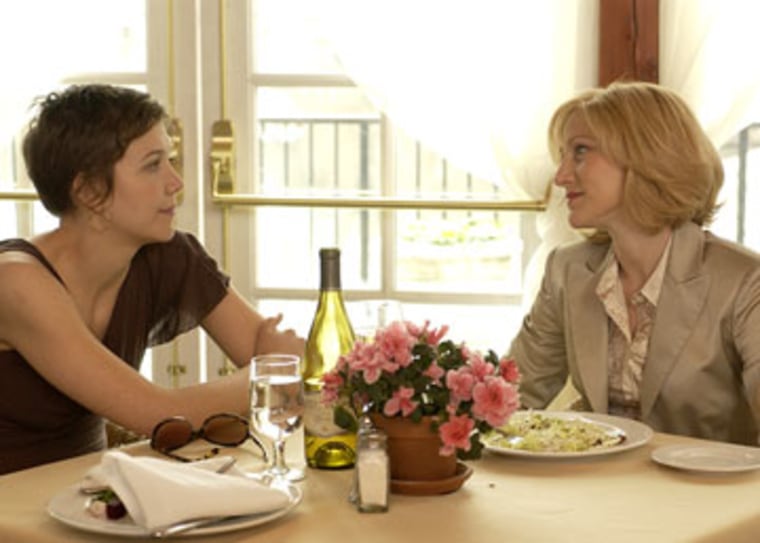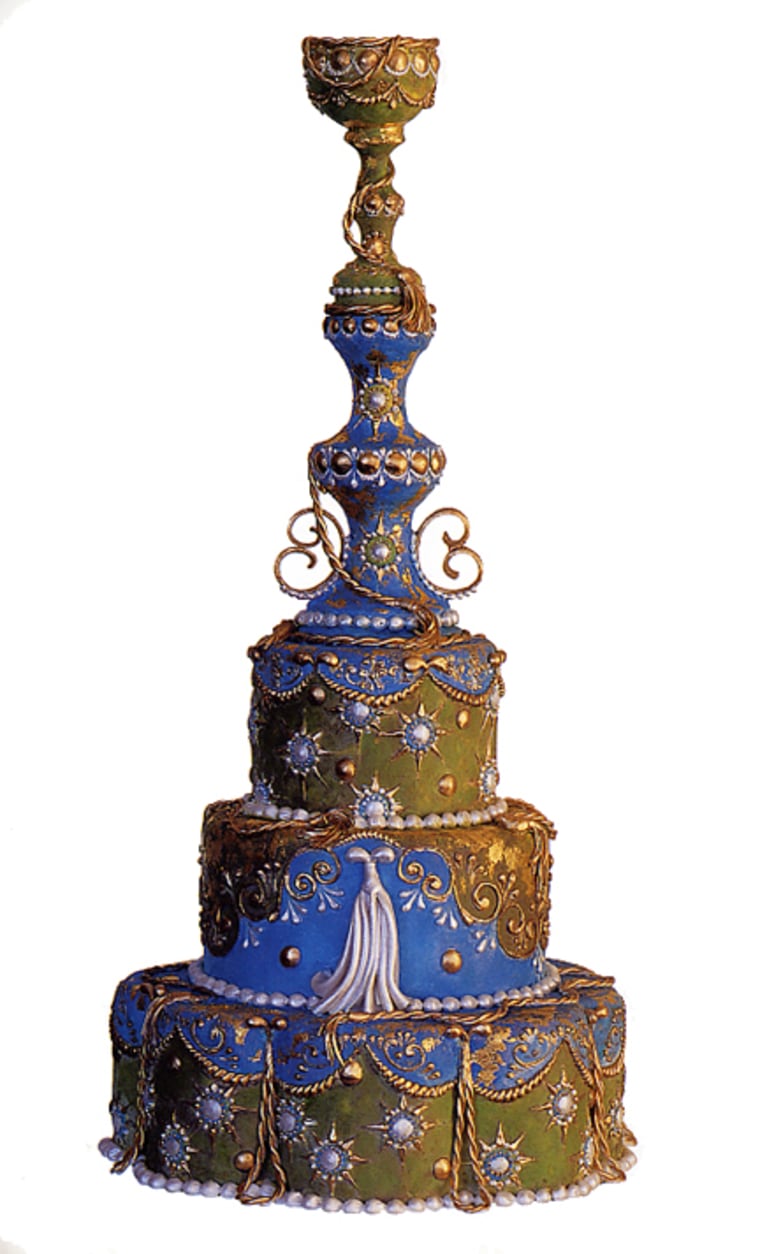In the new movie “The Great New Wonderful,” Maggie Gyllenhaal plays Emme Keeler, an aggressive, insensitive business woman we see making a presentation with a portfolio of sketches in hand and a mini-entourage of 20-something lackeys in tow.
Is she a high-powered ad woman ogling to snare a million-dollar account? A brittle corporate executive who’s managed to penetrate the glass ceiling?
Nope. Emme is a high-end cake designer in New York City. She’ll create a masterpiece for $1,800 at $14 a slice — The Great New Wonderful is the name of her business — and she wants more than anything to topple the reigning Queen of Cake, Safarah Polsky, portrayed by Edie Falco. The movie, set in a post-9/11 New York, opened Friday in New York, Boston and Washington.
Credit Margaret Braun, a real-life cake designer who was a consultant on the film, for the visuals that illustrate this delicious — and often poignant — rivalry. It’s enough to whet the appetite of anyone eager to embark on a hot high-profile career.
The featured dreamy pink confection — Emme is seen putting a finishing touch on the bow of a cascading sugar ribbon — was created by Braun especially for the film.
“It’s a combination of a few of the different motifs I’ve used in other cakes,” says Braun, who’s been in the business for 15 years and describes her style as sculptural, with a high concentration on classical technique. “I’m a total perfectionist when it comes to symmetry and line,” she says. If Braun were to recreate that exact cake for a real-life customer, the price would be much higher — about $5,000 — than the figures Emme quoted.
The photos used during the presentation scenes are of Braun’s cakes — they’re directly from her book “Cakewalk: Adventures in Sugar with Margaret Braun.” The sketches? Also from Braun, who recreated for the movie her original illustrations of cakes for personal clients. She draws not with ink but food coloring.

Unlike Emme, Braun does not have a series of cakes named for Shakespeare’s heroines. And, she says, she does not share Emme’s cutthroat competitive streak, either, even though the market itself is a competitive one.
“I don’t take on tons and tons of work, and I usually work on very special, really big fabulous projects, so there’s always work for me,” says Braun. “But there are cakes to be made. There are weddings happening in New York every weekend, and not everyone wants to spend thousands of dollars on cakes. There are newer people who are terrific and may not be quite as expensive as I am. So, it’s a very open field. If your product is really, really good, the work will come.”
Ron Ben-Israel, a high-end cake designer and trained pastry chef, has built a multimillion-dollar business in Manhattan — one of his regular clients is Uma Thurman — since starting in the field about 10 years ago. Ben-Israel, who has nearly a dozen people working under him, has also noticed a shift in the industry. “There’s a lot of talent out there,” says Ben-Israel, whose minimum charge for a birthday cake that can serve 30 people is $500 and who has charged as much as $25,000 for one of his creations.
“In the last five or six years, the demand for me to teach and appear at cake demonstrations has been great,” says Ben-Israel, who is known for his “shoe-box” cakes with edible designer sugar shoes perched on top. “It’s amazing, people will pay any price to come and attend a demo. They just want to get a little glimpse of secrets.”
And despite the fact that many people receive diplomas or certifications from baking programs every year — Ben-Israel is also a professor at the French Culinary Institute — he believes the industry can accommodate many of newbies.
“There are many levels to the art and different price points,” he says. “Some people will become ‘names,’ and others will work in hotels and resorts and bring up the level" of those establishments, he says, even if it’s just sculpting marzipan carrots for a carrot cake.
There appears to be rising interest in high-end cake design and decorating, says Carol Rockey, president of International Cake Exploration Societé, a U.S.-based organization whose 4,000 members are devotees of sugar art, which includes icings, fillings and decorations that often include objects sculpted from a sugar medium. The reason for the wider appeal, she says, is more people are attending cake-decorating classes to improve their techniques. “These classes would not exist without demand,” says Rockey.
Andrea Tutunjian, the head of the pastry and baking program at the Institute of Culinary Education in New York, says the demand for these courses has grown at the school, noting that a “tiered-cake” section is now part of the curriculum.
“What people are seeing is the amount of money the skill can command if you’re high-end,” says Tutunjian, adding that many students want to go into business for themselves. However, she concedes, not everyone has the patience to put in years of hard work.
“Some people underestimate that it’s easy,” she says. “But it’s not so easy. It takes years and years to master the skill and to be perfect. It involves hours and hours or practice and doing something thousands of times.”
Sylvia Weinstock, the cake designer who many would agree jump-started the industry in 1980, says she frequently gets calls from people who want to be cake decorators. Many of these people, she says, think “it’s great fun,” and don’t realize the hours and concentration involved.
“They want instant success and haven’t paid their dues,” says Weinstock, who wrote “Sweet Celebrations: The Art of Decorating Beautiful Cakes,” and whose clients have included Catherine Zeta Jones and Mariah Carey. Her advice to up-and-comers is to start small, advancing from “beautiful one-layer cakes to something a little grander.”
The impact of the finished product tends to be enough to seduce an ever increasing number of aficionados. What’s the mystique?
For Weinstock, it’s the "wow" element. “Everyone wants a beautiful cake that’s the spotlight for a gorgeous event,” she says.
For Braun, “it’s cake — it’s immediately attractive and appealing to every human being.” And, in addition to the look of it, finanicial remuneration is another lure.
“The price point for cakes is extremely high,” says Ben-Israel. “A cake for 200 people will usually be between $3,000 to $4,000. So, this sounds like a lot of money, and a lot of people are thinking, ‘If this is what I can do on a cake, I should take it on.’”
They don’t call it “sugar dough” for nothing.
